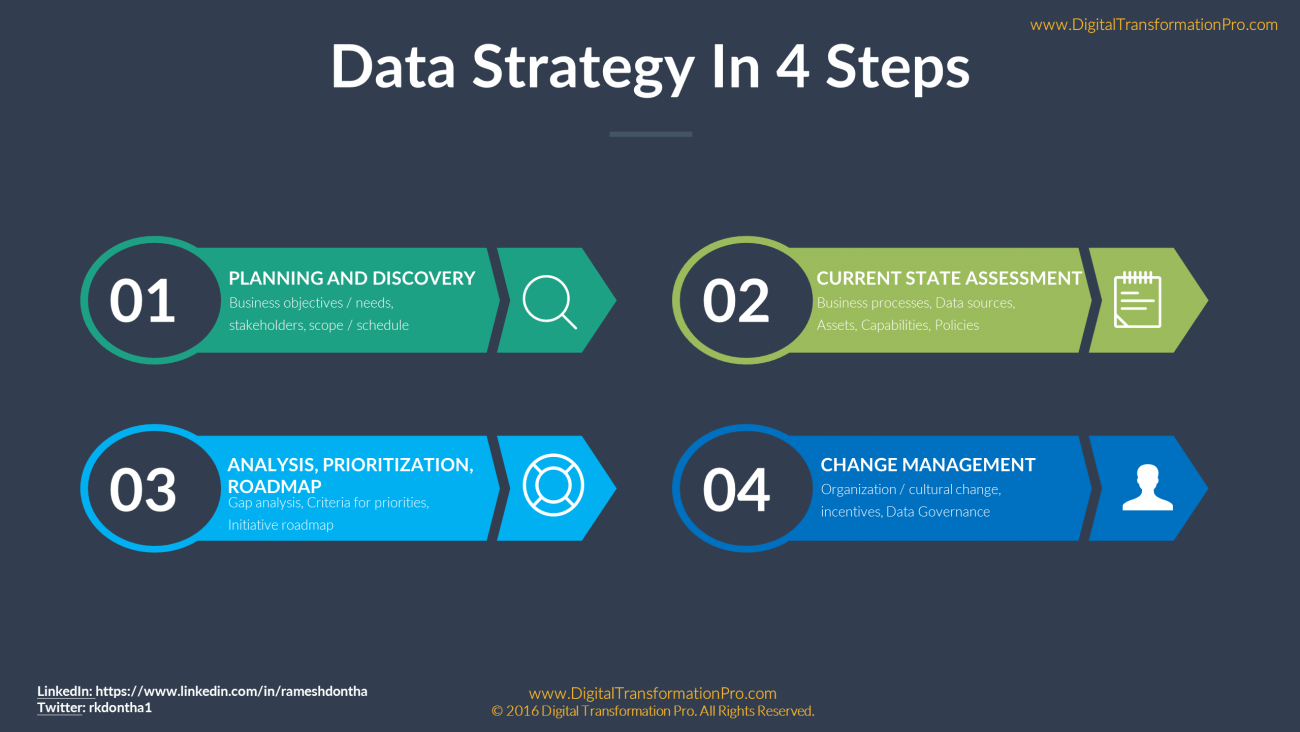How to Build a Data Strategy Pt. II
- by 7wData

This is Part 2 of data Strategy series discussing “How To” following Part 1 of data Strategy that dealt with “5 ‘W’s of Data Strategy”.
As I mentioned in Part 1, a good enterprise Data Strategy should be actionable to your specific Organization and evolutionary to adjust to disruptive forces. Now let’s discuss the process to guide your Organization to lay out your organization-specific Data Strategy. It is a 4 step process that I’ve used often and this high-level framework for Data Strategy addresses the key elements of People, Processes, Technology, and Data.
This step encompasses identifying business objectives & needs, enlisting sponsors & stakeholders, defining scope & schedule, and discovering technology & data assets that have a role in the Data Strategy. I’ll dig little more into business objectives and stakeholders points which I believe are very crucial.
Identify Business Objectives and Problems that need to be solved with data
Data Strategy should align to business objectives and address key business problems / needs as the primary purpose of Data Strategy is to unlock business value leveraging data. One way to accomplish this is to align with corporate strategic planning process as most organizations have a strategic planning process anyway. Some of the examples for business objectives / business needs: Drive customer insights, Improve product and services efficiently, Lower business risks, Drive revenue growth and/or profitability, Regulatory compliance
In my opinion, there are 3 types of people you need to take into account.
(a) Executive sponsor(s) : I can’t under estimate the importance of finding and aligning with Executive sponsor (s) that’ll support you through the ups and downs of formulating the Data Strategy and implementing it.
(b) Right talent on your team: Make sure to influence and evangelize to the people with right skills / talent to be on your team. Explore both internal talent as well as external consultants.
(c) Potential trouble makers: Every project / initiative will have some ‘stakeholders’ who either deliberately or unintentionally are opposed to change. Knowing who they are and their motivations upfront will help you later in the process.
In this step, focus primarily on current business processes, data sources, data assets, technology assets, capabilities, and policies. The purpose of this exercise is to help with gap analysis of existing state and the desired future state. As an example, if the scope of the data strategy is to get a 360 view of customers and potential customers, the current state assessment would include any business process, data assets including architecture, capabilities (business & IT), and departmental policies that touch customers. Current state assessment is typically conducted with a series of interviews with employees involved in customer acquisition, retention, and processing.
One important observation I made during assessment is that you’ll come across people in the organization that are natural data evangelists. These people truly believe in the power of data in making decisions and may already be using the data and analytics in a powerful way. Make note of these people and make sure to take their help in later phases to drive a ‘data-driven’ culture in the organization.
[Social9_Share class=”s9-widget-wrapper”]
Upcoming Events
Evolving Your Data Architecture for Trustworthy Generative AI
18 April 2024
5 PM CET – 6 PM CET
Read MoreShift Difficult Problems Left with Graph Analysis on Streaming Data
29 April 2024
12 PM ET – 1 PM ET
Read More




